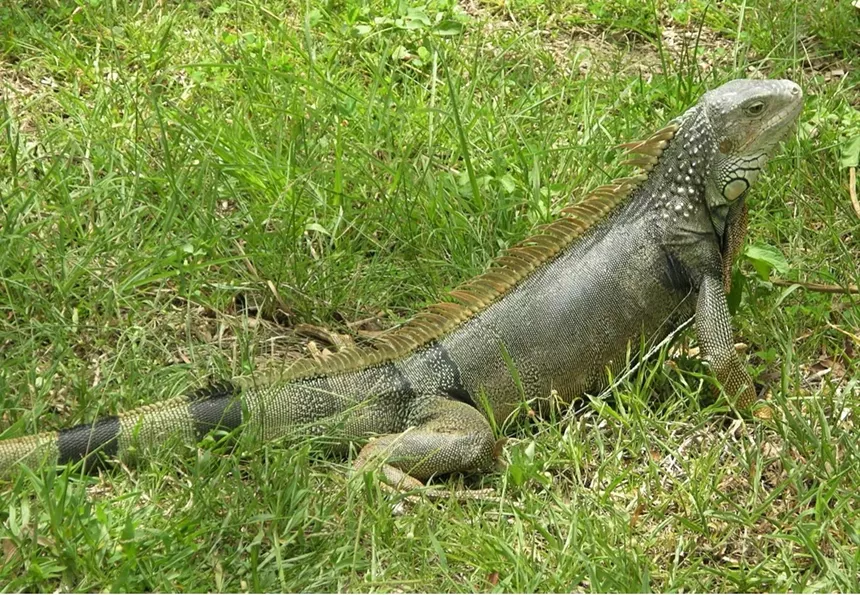Yes, you read that right: Iguanas. Plummeting. From. Trees.
A word to the uninitiated: Before you start picturing a scaly apocalypse, let's clear up why these Jurassic Park extras are falling from the sky and why Floridians seem to roll with it like everything's normal.
Falling Iguanas: The Science of the Drop
Green iguanas are cold-blooded reptiles, meaning their internal thermostat depends entirely on the weather. When it's sunny and 75, they live their best lives, sprawling across seawalls and feasting on nickerbean (AKA gray nicker), the host plant of the endangered Miami blue butterfly. But when the mercury falls below 50 degrees Fahrenheit, it's game over — or at least a temporary pause. The iguana's body goes into a cold-induced paralysis, leaving it frozen in place or, more often than one might imagine, falling out of trees. This phenomenon, known as "cold-stunning," explains why your backyard may suddenly resemble an iguana obstacle course during a Florida cold snap.
How Did We Get Here?
You might say iguanas aren't supposed to be here. But their ubiquity in Florida, while a relatively recent phenomenon, is entirely the work of human beings. They didn't swim here.Native to Central and South America, these striking green interlopers were first spotted in Miami suburbs like Hialeah and Coral Gables back in the 1960s. Blame the exotic pet trade because what screams "Florida chic" more than a pet lizard? (Or a Burmese python.) People released them into the wild — sometimes accidentally, often intentionally, and like us, they found Miami's tropical climate much to their liking. The decades passed, and we've found ourselves with an iguana infestation.
The critters have no natural predators in Florida, and the Sunshine State's abundance of water, sun, and food makes it feel like Club Med to them.
Their growing population comes with major side effects, however. They love to feast on endangered tree snails, dig burrows that collapse lawns and sidewalks, and, in some cases, make surprise cameos in toilets.
As noted in a comprehensive publication from the University of Florida's Institute of Food and Agricultural Sciences, they can also create hazards in other unexpected areas. In one instance, an iguana darted into the road, causing a bicyclist to crash and require stitches. At Miami International Airport, iguanas basking on runways have delayed flights.
Here’s a first for yours truly, ESPN’s resident Florida Man. Our toilets haven’t been effectively flushing last few days. No idea why. Until I just walked into our bathroom to find this… 😳😂
— Jeff Darlington (@JeffDarlington) August 11, 2024
It tried to go BACK down the toilet pipe… had to grab it by the tail and pull it out. pic.twitter.com/XhILeYf0SA
Sinkholes, Bounties, and Tacos
Falling from trees isn't the iguana's only claim to fame. In one Key Largo incident, iguanas caused a sinkhole by tunneling near a road culvert. Cities like Miami Beach have quadrupled their iguana removal budgets, with some residents calling for bounty programs. (Farther afield in the Caribbean, the Cayman Islands introduced a bounty system that helped reduce the iguana population by more than 1 million over the course of a few years — albeit perhaps only temporarily.)Meanwhile, some Floridians are turning lemons into lemonade — or rather, iguanas into tacos. Nicknamed "chicken of the trees," iguana meat is a delicacy in some cultures, and recipes for tacos, stews, and even burgers are gaining traction.
What Should I Do if I See a Frozen Iguana?
According to the Florida Fish and Wildlife Conservation Commission (FWC), it's best to let nature take its course. Don't bring a cold-stunned iguana indoors — it might recover quickly and, once thawed (as it were), might not appreciate your hospitality.The FWC encourages homeowners to humanely euthanize iguanas on their property, as they're considered invasive species. But the agency-specified killing methods [Editor's note: Don't say we didn't warn you] — i.e., a two-step process that requires an air gun or captive bolt, followed by a screwdriver through the skull "using deliberate, multi-directional movement, ensuring destruction of the entire brain" — might not be your idea of a fun cold-weather family activity.
Furthermore, the FWC has declared green iguanas a "Prohibited Species," banning the sale, breeding, and ownership of new pets with few exceptions. Existing pet owners must microchip their iguanas and apply for permits.
A Quirky Florida Reality
Humane euthanasia aside, Zoo Miami communications director Ron Magill assures his fellow Miamians that falling iguanas aren't anything to lose sleep over. While an iguana landing on you might feel like a scene straight out of a cartoon, Magill says you're more likely to be bitten by a stray dog.Some unfortunate souls — like the Miami yogi whose savasana was interrupted by a 20-pound green iguana to the noggin — might argue otherwise.
So, as South Floridians look forward to the inevitable (if occasional) winter chill, remember to grab your sweater and keep an eye on the trees because there's always a chance for a passing cold front to bring scattered iguana showers.












